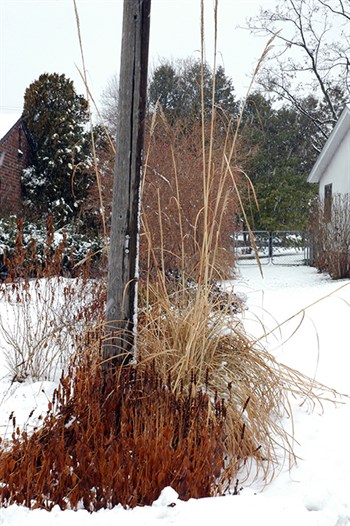Tidiness is not paramount in my garden, and working when
it's cold is not my strong suit. Is it absolutely necessary to clip
a garden down and weed it and so on in fall? - J.S. -
To let it go...
A garden must please its owner. If you enjoy an unclipped
garden, let yours stand tall over winter. It has its own charms,
such as offering more shelter and forage for birds and beneficial
insects, and leaving a taller, thicker cushion between the soil and
soil-crumb-destroying hard rain or pelting hail.
To cut it down...
On the other hand, an intact garden conceals weeds, might allow
disease or insect problems to build up from minor to major level,
and can cost a gardener significant time, come spring. (See
below).
The compromise:
We compromise. We don't go out and clean up a bed all in one day
but cut back gradually over a month or so. We remove plant parts
that had a significant disease- or insect problem and anything that
falls down or stops contributing to the garden's good looks.
Eventually, the only stuff left is attractive, healthy and sturdy
enough to stand through winter.






(See these larger.)
Uses for the cuttings
We often bundle what we cut, tie those sheaves with string and
lay them down along a garden's edge after we weed. They form a
windbreak, offer seed to birds and contribute to the reservoir of
beneficial insects or fungi in spring.

Still standing in our gardens most Halloweens are peonies with
healthy foliage and good fall color, still-blooming mums and
asters, sturdy turtlehead (Chelone) stems with handsome
seedheads, ornamental grasses, evergreen subshrubs such as
lavender, etc. We'll enjoy all of them until a hard freeze comes,
then cut a few more and leave others right through winter. Early in
spring we'll cut what remains.
Right: Ravenna grass (Erianthus ravennae) with the
red brown stalks of turtlehead (Chelone obliqua) at its
feet.
Look around for more fall color
Looking for more fall color in your perennial garden? Go look at
labeled display gardens, such as at Specialty Growers in Howell,
Michigan where some of the peonies strut their stuff each fall.
Note the best looking varieties to add to your own collection.
Never-cut garden is possible, just periodically shaggy
Even if you do no cutting in fall, cutting can still be optional
in spring. Plants do just grow back through their old debris.
However, many people can't bear the shaggy transition, with old
plant parts visible into June, and the omnipresent tangle does make
weeding and dividing more difficult.
If you'd rather not learn this wilder approach to
gardening but time savings are important, act now to do a clean up,
because fall is the most productive season.
Our records over many years tell us that waiting to work in
spring can mean spending three hours in a bed that could have been
whipped into shape in one hour in fall. Reasons for this
include:
• Cutting firm, crisp stems in fall is easier and quicker than
clipping away mushy debris in spring.


• Clipping a whole batch of stems to the ground when new basal
growth is nil is quicker than cutting old stems one at a time from
among emerging new stalks.
• Plants plug away all winter and get ahead of us. They are not
dormant through winter, but grow into early winter and resume
growing on moderate days in late winter and very early spring so
that weeds and unwanted perennials can be much more difficult to
remove by spring. Lawn at a bed's perimeter can grow 18" into a bed
between November and April.
• "Free" mulch in the form of fallen leaves is readily
available. Leaves can fall to cover a well-weeded bed, stretching
the effect of that work. Having large quantities of leaves is also
great if we employ the labor-saving technique of smothering areas
too weedy to be efficiently readied for new planting. When that
area is cut short, covered with newspaper and then a heavy mulch
layer (leaves!) the growth of plants in it is prevented or slowed.
The space looks neat during the smother period and may be ready to
be sown with grass seed or replanted in low care groundcovers and
shrubs by the following summer, all without laborious weeding.

• There's a psychological advantage in working with plants going
dormant. We are less likely to be rushed, overwhelmed and prone to
misjudgment now. These hazards are real in spring when green shoots
are popping up underfoot as we work.
• We're all younger and in better shape each fall than the next
spring. Thus we work more efficiently now.